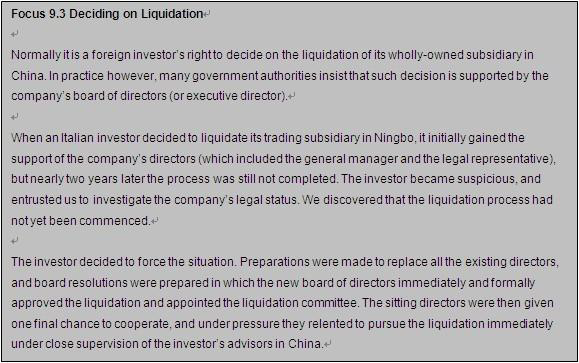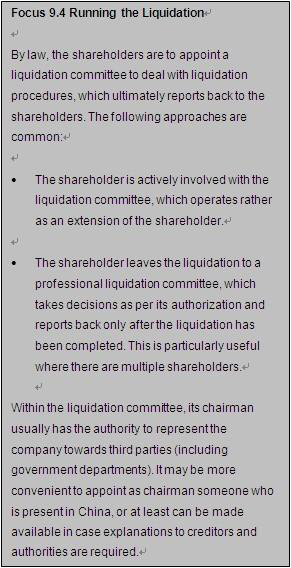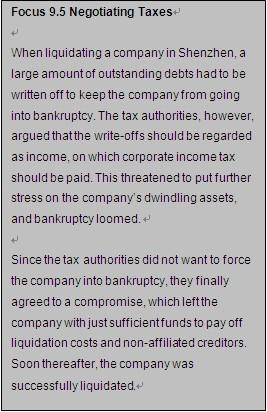Company Liquidation in China: Key Challenges to Wind-up your Chinese Company
Where a buyer cannot be found, or the income from a sale does not measure up to the remaining liquidation value of the assets, the most common alternative is to wind-up the business.
Liquidation refers to the voluntary termination of the company’s operations and its formal termination. After layoffs of employees, selling remaining assets and settling any debts, the company’s registrations with the various government departments can be cancelled, and lastly, the remaining capital will be returned to the investor.
The greatest benefit to voluntary liquidation, from an investor’s point of view, is the high level of control over the company in its final phase. The shareholder will appoint the team that deals directly with all outstanding issues, thereby allowing the shareholder to influence and control the process with minimum dependence on any third parties. This process, however, is not without challenges either. In practice, liquidating a company is time-consuming, demands considerable effort and, in many cases, may be costly as well. One rule of thumb: the longer the company has been operating and the more complex its business, the more challenges its liquidation will present and the greater the effort needed to overcome these challenges.
Liquidation Fillings
Normally it is a foreign investor’s right to decide on the liquidation of its wholly-owned subsidiary in China. In practice however, many government authorities insist that such decision is supported by the company’s board of directors (or executive director).
When an Italian investor decided to liquidate its trading subsidiary in Ningbo, it initially gained the support of the company’s directors (which included the general manager and the legal representative), but nearly two years later the process was still not completed. The investor became suspicious, and entrusted us to investigate the company’s legal status. We discovered that the liquidation process had not yet been commenced.
The investor decided to force the situation. Preparations were made to replace all the existing directors, and board resolutions were prepared in which the new board of directors immediately and formally approved the liquidation and appointed the liquidation committee. The sitting directors were then given one final chance to cooperate, and under pressure they relented to pursue the liquidation immediately under close supervision of the investor’s advisors in China.
Under the Company Law, the decision to liquidate a company may be taken by shareholders representing at least two-thirds of the voting rights, though many companies adopt the articles of association, which stipulates that the decision to liquidate must be taken unanimously by either the shareholders or the company’s directors, or both groups. In practice, irrespective of the rules, many local authorities will in any event insist on a unanimous decision to minimize the risk of a shareholder’s dispute. [Focus 9.3]

If the desired quota cannot be obtained, shareholders representing at least 10% of the voting rights may file a lawsuit against the company for its dissolution, but only where the shareholders have been deadlocked for at least two years; where long-time conflict between the company’s directors is combined with serious operational or management difficulties; or where, in the face of such difficulties, the company’s continuous existence threatens to cause major damage to the interests of the shareholders. In addition, shareholders may file a lawsuit for the company’s dissolution under other conditions stipulated in the articles of association, or where the business license expires. In fact, there have been few examples of enforced dissolutions, and so there is a great measure of uncertainty regarding how China’s courts will respond to such applications. To date, most filings for liquidation have been initiated on a voluntary basis.
Liquidation Committee
Upon rendering the decision to enter into liquidation, after having obtained approval and registering the liquidation with the competent authorities, the shareholders must appoint a liquidation committee comprised of at least three members. The liquidation committee will be charged with the responsibility of the liquidation process, and as such will be making most of the decisions. The law sets few requirements on the composition of the liquidation committee of a limited liability company, although local authorities may have their own demands. In some cases, for example, the Chairman of the board of directors or another director of the company is asked to be included. [Focus 9.4]
 By law, the shareholders are to appoint a liquidation committee to deal with liquidation procedures, which ultimately reports back to the shareholders. The following approaches are common:
By law, the shareholders are to appoint a liquidation committee to deal with liquidation procedures, which ultimately reports back to the shareholders. The following approaches are common:
- The shareholder is actively involved with the liquidation committee, which operates rather as an extension of the shareholder.
- The shareholder leaves the liquidation to a professional liquidation committee, which takes decisions as per its authorization and reports back only after the liquidation has been completed. This is particularly useful where there are multiple shareholders.
Within the liquidation committee, its chairman usually has the authority to represent the company towards third parties (including government departments). It may be more convenient to appoint as chairman someone who is present in China, or at least can be made available in case explanations to creditors and authorities are required.
In practice, the priority of most shareholders is to appoint members that will represent their own interests, although in fact the members of the liquidation committee have a fiduciary duty towards the company and its creditors (including, but not limited to, its shareholders), and may be held accountable if any laws, administrative regulations or the company’s articles of association are violated or breached. Should any member of the liquidation committee cause losses to the company or any creditor intentionally or due to gross negligence, he or she may be held personally liable for such losses. This is one reason why the liquidation committee sometimes includes independent lawyers or accountants to bring in the necessary expertise and carefully balance responsibilities to the various parties involved, though such expertise may also be retained in an advisory role. Including a manager with a thorough understanding of the company’s business dealings and is familiar with (former) employees, suppliers, customers and government authorities is usually useful as well. Unfortunately this is not always feasible, as many investors prefer to relocate commercial managers to more productive positions, leaving the liquidation for legal or financial staff to deal with. If so, it is of paramount of importance to ensure that these persons have sufficient access to the company’s information in order to organize the liquidation in an efficient way and avoid too many surprises.
Once the liquidation process has officially commenced, the liquidation committee should first assert its control over the company by taking physical possession of the company’s stamps, licenses and access to bank accounts, and by ordering the halt of any new business initiatives. In fact, the company by law must refrain from all business activities except clearing up existing orders and selling any remaining inventory. Steps should then be taken to resolve outstanding commercial matters, such as terminating employment agreements and commercial relationships, collecting on or writing off debts, selling off assets and paying creditors; to deal with reporting requirements, including the liquidation report and the audit report; and to arrange for government approvals and de-registration procedures. All these matters are generally within the purview of liquidation committee, though under supervision of or with permission from the shareholder.
Key Challenges
One of the most contentious steps in the liquidation process is to lay off employees. Liquidation presents a lawful ground for terminating employment contracts, but this does not imply that all costs pertaining to employees will thereby be discharged (see Chapter 11 on Employment). Severance pay, calculated with reference to their salary and the number of years that the employee has worked for the company, is due and can generally be paid immediately upon termination of the employment relationships.
Employees need not to be laid off all at once. Oftentimes a company will do well to retain a small team of key employees to assist the liquidation committee in resolving outstanding issues. Two common examples of employees often retained for some time are the sales manager, who is familiar with the company’s customers and may therefore be in a better position to collect on outstanding accounts; and the accountant, who with his or her knowledge of the company’s accounting books could greatly facilitate the company’s financial closing.
While employees may be paid off first, the liquidation committee should legally refrain from paying off other creditors until after the liquidation report has been approved. First it should terminate existing commercial relations, try to collect on outstanding debts, and liquidate any remaining assets into cash. The liquidation committee is entitled to pursue any debts of the company, and may file lawsuits against debtors on the company’s behalf. However, there is a drawback to this opportunity. Where a company has already entered into liquidation, its debtors oftentimes see little benefit in paying up; while lawsuits to pursue such debtors may be expensive and will prolong the liquidation; as long as the litigation is not settled, the company cannot be liquidated. A better alternative is sometimes to transfer any credits to a third entity, which will then take over the rights to file a lawsuit against the debtor. This can be practical, but only if the shareholder has a convenient vehicle available (e.g., another subsidiary in China), and if the debts are big enough and the evidence is strong enough to make their pursuit relatively easy.
When the liquidation committee attempts to sell its remaining assets, it may confront a similar problem: a potential buyer will offer less than its worth in the knowledge that the company must sell the assets. For this reason, many investors will decide to resolve certain commercial matters before the liquidation officially commences. Legally the selling of assets within one year before commencement of the liquidation can be challenged by creditors who suffer losses due to such actions. But as long as there are sufficient funds to pay all the company’s creditors, these activities are usually condoned.
When liquidating a company in Shenzhen, a large amount of outstanding debts had to be written off to keep the company from going into bankruptcy. The tax authorities, however, argued that the write-offs should be regarded as income, on which corporate income tax should be paid. This threatened to put further stress on the company’s dwindling assets, and bankruptcy loomed.
Since the tax authorities did not want to force the company into bankruptcy, they finally agreed to a compromise, which left the company with just sufficient funds to pay off liquidation costs and non-affiliated creditors. Soon thereafter, the company was successfully liquidated.
On the other hand, if funds are insufficient to pay off all creditors, then any creditor unhappy with the liquidation committee’s performance may file for the company’s bankruptcy. The threat of bankruptcy is meant to encourage the investor and the liquidation committee to resolve any debts in a proper way; in practice, investors may even partially or fully write-off of debts to affiliates. A large part of the business of foreign-invested companies has traditionally been with affiliated entities abroad, and where the company is insolvent, such debts are often the first to pile up. Because in bankruptcy the investor will unlikely be able retrieve much of its investment anyway, writing off the subsidiary’s debts to stave off bankruptcy can be considered. Note that when making such a decision, an investor should also consider the tax consequences of such a write-off: tax authorities may deem the amount written off as income, in which case it will be subject to corporate income tax (after deduction of losses).
Negotiating with the tax authorities in particular, and with other government departments in general, is the most challenging part of the liquidation process. The various relevant supervising departments have the authority to require the company to resolve of any and all outstanding issues before they approve de-registration; therefore, at this point skeletons can often come out of the closet. Most common are unpaid taxes, though issues relating to social insurance, foreign exchange, customs duties, missing board resolutions and approvals are also common. Many of these issues tend to take the liquidation committee by surprise, especially if they occurred a long time ago; moreover with the company’s pending dissolution, the liquidation committee has little bargaining power to negotiate with these authorities, even if their demands seem unreasonable. Most important, this increases the cost of the liquidation, which is something that investors must be prepared for. [Focus 9.5]
 The challenge of negotiating with government officials exemplifies the biggest drawback of liquidation as an exit strategy. In voluntary liquidation, the company is presumed to have sufficient assets to cover its debts – perhaps excluding debts that can be easily written off, such as those to affiliates. But while this presumption may ring true at the start of the liquidation, the situation may change as outstanding credits become uncollectible, and creditors – including employees, suppliers and government departments – start making their claims. If the financial pressure becomes too great, there may be no better alternative than to file for bankruptcy – which places the company in the hands of the court.
The challenge of negotiating with government officials exemplifies the biggest drawback of liquidation as an exit strategy. In voluntary liquidation, the company is presumed to have sufficient assets to cover its debts – perhaps excluding debts that can be easily written off, such as those to affiliates. But while this presumption may ring true at the start of the liquidation, the situation may change as outstanding credits become uncollectible, and creditors – including employees, suppliers and government departments – start making their claims. If the financial pressure becomes too great, there may be no better alternative than to file for bankruptcy – which places the company in the hands of the court.
